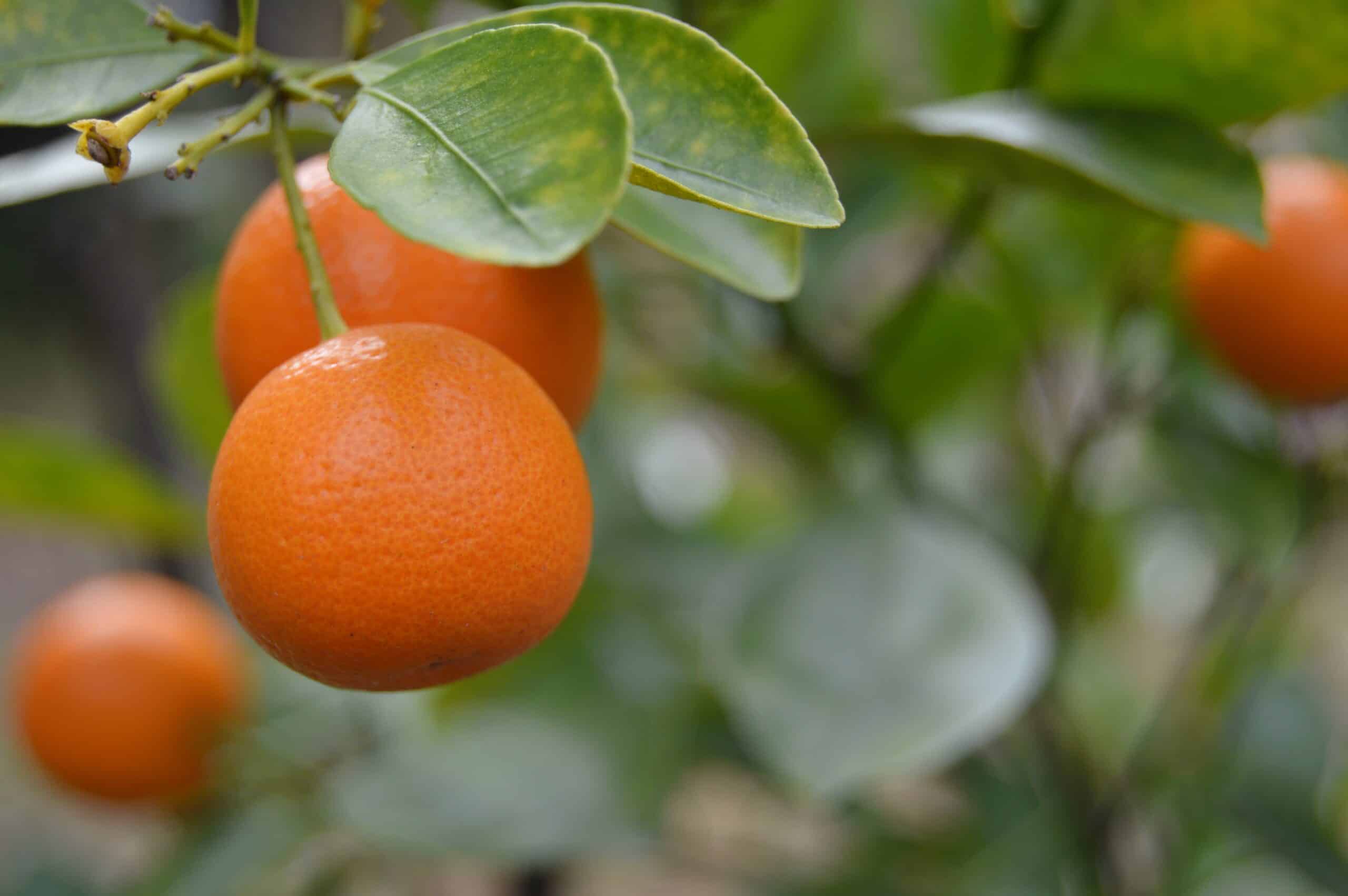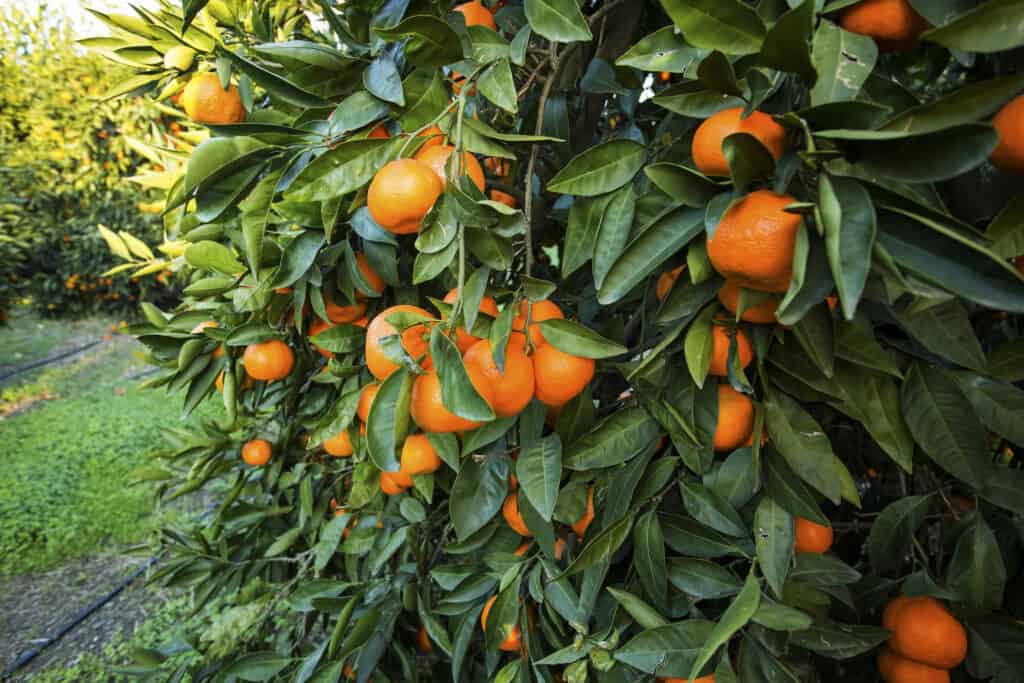Tangors are sour-sweet and full-flavored citrus. They are hybrids between mandarins and sweet oranges. Tangors are sometimes mislabeled as oranges.
Tangors have bright orange rinds and pulps. Though their rinds are thick, tangors are easy to peel.
The name “tangor” is a formation from the “tang” of tangerine (a name often applied to deep orange-colored mandarins) and the “or” of “orange”.
Related articles:
- Ways to Serve Oranges
- Ways to Serve Mandarin Orange
- Ways to Serve Lemons
- Ways to Serve Grapefruit
- Ways to Use Limes

The tangor variety ‘Temple’ is widely grown. It is often sold as Temple Orange, even though it more closely resembles a mandarin than an orange—like most tangors.
Tangor is an evergreen citrus tree. A standard tangor can grow 20 to 30 feet tall and 15 to 25 feet wide. Trees on dwarfing or semi-dwarfing rootstock will grow to one-fourth to one-third the size of a standard, that is 5 to 7 feet tall and wide.
Best climate for growing tangors
Tangors grow best in USDA Zones 9 and 10. Tangors are nearly as hardy as oranges only smaller. They are well adapted to areas of Florida where sweet oranges grow. Most are naturally occurring not breeder developed.
Where to plant tangors
- Choose a location that gets at least 8 hours of sun or more each day. Set tangors in a protected spot away from a prevailing breeze or wind. Avoid planting in low spots where cold air or frost can settle.
- Plant tangors in compost-rich, loamy soil that is well-drained. Keep the soil evenly moist. Protect plants with plant blankets if temperatures near freezing are forecast.
Growing tangors in containers
- Dwarf tangors can be grown in containers. Choose a container at least 18 inches deep and wide. Move tangors to larger containers after a year or two.
- Tangors can be grown indoors in a very brightly lit spot. Potting soil should be coarse, acidic and well-drained. Tangors growing in containers in cold-winter regions should be moved indoors in autumn before the first frost.
Tangor pollination
- Tangors are self-fertile. You can help a tree set fruit by taking a small brush and moving pollen from one flower to another. Honeybees and other pollinators can assist as well. Trees will begin bearing fruit at 1 to 2 years old. A mature tree will bear 40 to 50 fruits. Fruits commonly ripen from winter into spring.
- Tangors are hardy to the mid-20sF. Protect plants from freezing temperatures to avoid dieback or death. The fruit must be protected from temperatures below freezing.
Feeding tangors
- Feed tangor trees in mid-spring, early summer, and late summer. Use an organic fertilizer formulated for citrus trees, generally higher in nitrogen than phosphorus and potassium.
How to harvest tangors
- Take care when harvesting fruit not to pull the fruit or the rind will tear around the stem; cutting stems with pruning shears is the best harvest practice.
Tangor pests and diseases
- Tangors, like other citrus, are usually not bothered by insect pests.
- Watch for slugs or leafminers. Indoors watch for mites or aphids.
Tangor varieties for home gardens
‘Ellendale’: rich excellent flavor, subacid, very juicy; medium to large fruit somewhat flattened with short neck; matures late; orange-red, medium-thin rind smooth to faintly pebbled; easy to peel; few seeds if not cross-pollinated; fruit loses quality if left on tree; round vigorous tree; thornless; cold-hardy; limbs can split under heavy crop.
‘King’: rich flavor and moderately juicy; oblate, large fruit with thick yellow-orange rind that varies from smooth to very rough; deep orange flesh; peelable; a moderate number of seeds; ripens late; fruit stores well on the tree; the medium-sized tree grows well and has an open, upright form; thornless; requires very hot climate to mature fruit of acceptable quality; the tree is cold-resistant but less so than most mandarins.
‘Murcott’ also marketed as ‘Honey’ tangerine by Florida growers: very sweet flavor; medium size fruit; very juicy; bright yellow-orange rind; thin-skinned; few to many seeds; easy to peel; matures late winter into spring; fruit holds well on tree; vigorous, upright tree with willowy branches; tends to bear heavily in alternate years; branches often bent or broken by heavy fruiting at the ends; widely grown in Florida; sensitive to cold; the origin of Murcott is unknown and its history obscure; ‘Murcott’ is one parent ‘W. Murcott’ also called ‘Afourer’ is widely grown in California, the other parent is unknown.
‘W. Murcott’ also called ‘Afourer’ and ‘W. Murcott Afourer’: rich and sweet flavor; juicy orange-colored; flesh; fruit is usually flattened with a thin, smooth, orange rind that is easy to peel; few seeds when not cross-pollinated; fruit matures late winter into spring; moderate size tree; susceptible to alternate-bearing; fruit holds well on the tree. ‘W. Murcott Afourer’ originated as a seed from a ‘Murcott’ tree, a chance hybrid of ‘Murcott’ and an unknown pollen parent. ‘Murcott’ is a different variety from ‘W. Murcott’. ‘Murcott’ is commonly called ‘Murcott Honey’ because the commercial name of ‘Murcott’ was changed in Florida to ‘Honey’ a number of years ago, so to distinguish it from a California mandarin called ‘Honey’, it is generally called ‘Murcott Honey’. This also helps distinguish it from ‘W. Murcott’. ‘W. Murcott’ is also often called ‘W. Murcott Afourer’ or ‘Afourer’; a seedless cultivar of ‘W. Murcott’ is called ‘Delite’.
‘Temple’ also called Temple orange and Royal mandarin: a natural tangor discovered in 1896 in Jamaica; sweet to tart flesh; excellent for eating fresh or juicing; large, flattened fruit, sometimes with a neck; deep orange pebbled rind; seedy; ripens winter into spring; medium-size tree is spreading and thorny; cold-sensitive; high heat requirement; good grower in Florida and in desert regions; flavor is acidic and tart in cooler regions of West.
Also of interest:
Articles of interest:
Planning the Home Fruit Garden
Garden Planning Books at Amazon:
- Vegetable Garden Almanac & Planner
- Kitchen Garden Grower’s Guide Vegetable Encyclopedia
- Vegetable Garden Grower’s Guide
- Tomato Grower’s Answer Book
More fruit-growing articles:
Learn how to plant, grow, prune, and harvest your favorite fruits. Click below for all you need to know.
- Apple
- Apricot
- Avocado
- Banana
- Blackberry
- Blueberry
- Cantaloupe
- Chayote
- Cherimoya
- Cherry
- Citrus
- Clementine
- Cranberry
- Currants
- Elderberry
- Feijoa
- Fig
- Gooseberry
- Grape
- Grapefruit
- Guava
- Kiwifruit
- Kumquat
- Lemon
- Lime
- Loquat
- Mandarin
- Mango
- Melon
- Mulberry
- Muskmelon
- Nectarine
- Olive
- Orange
- Papaya
- Passion Fruit
- Peach
- Pear
- Persimmon
- Pineapple
- Pineapple Guava
- Plantain
- Plum
- Pomegranate
- Pumpkin
- Quince
- Raspberry
- Strawberry
- Tangelo
- Tangerine
- Tangor
- Watermelon
















